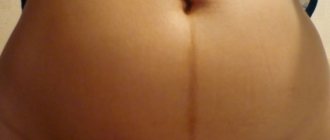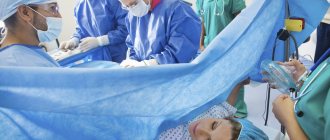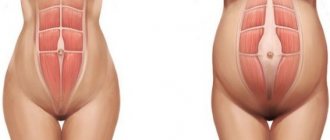Caesarean sections are now performed much more often than just 20 years ago. And the reason is not only the weakening of natural labor or complicated pregnancy observed almost everywhere, which previously were almost the only indications for surgical intervention. Many women themselves ask for surgery to avoid hours of labor pain and get a flat stomach as quickly as possible. And after a few hours, for the same reason, they begin to sleep on their stomach.
Is it possible to lie on your stomach after a caesarean section?
It is allowed to lie on your stomach after a cesarean section from the 3-4th day, but the woman in labor should not have severe, burning pain. In the first two days, restrictions are imposed on sudden movements, including turning on the side and stomach, as this complicates the process of primary healing of the postoperative suture.
As your general condition improves and pain decreases, sleeping or resting on your stomach even brings benefits, and the recovery of the uterus after childbirth is accelerated. Usually, in the first week, turning onto the stomach is carried out after an injection of an anesthetic and with the help of medical staff, and by the end of the second week the woman in labor no longer feels severe pain and turns over on her own.
How to sleep on your stomach correctly
Why lie down after a CS?
Lying on your stomach after a CS (caesarean section) is useful because this position:
- accelerates the release of postpartum lochia (discharge from the uterus), which stimulates the cleansing of the uterine cavity;
- helps reduce the uterus to normal size, restore its structure, which prevents future disruptions of the menstrual cycle;
- reduces the risk of extensive adhesions in the abdominal cavity, which then becomes the cause of chronic abdominal pain, intestinal dysfunction, decreased patency of the fallopian tubes, and infertility;
- strengthens the area of the postoperative suture on the skin, suppuration and fistula tracts occur less frequently, and the scar on the uterus is formed more durable and smooth;
- tightens the skin and normalizes muscle tone of the anterior abdominal wall, helps reduce abdominal volume;
- stimulates intestinal peristalsis (motor activity), which prevents bloating, pain and constipation in the postoperative period.
Postoperative suture
The position on the stomach also has a beneficial effect on the condition of the spine, it relieves muscle spasm that occurs in the last months of pregnancy from overexertion. Since the lumbar region bears the greatest load, a stronger deflection is formed, which disrupts the woman’s posture and changes the woman’s gait.
Changing your resting position at first is the safest way to improve the recovery of your intervertebral discs. Such passive gymnastics must be carried out in the first two months, while the sport remains prohibited.
We recommend reading about what exercises you can do after a cesarean section. From the article you will learn how long after a CS you can start training, permitted and prohibited exercises, contraindications to training. And here is more information about when you can pump up your abs after a caesarean section.
What are the dangers of sleeping early on your stomach?
Early sleep on the stomach is dangerous primarily due to difficulty in the outflow of fluid from the uterine cavity. This applies to women who have a bent organ or severe obesity.
Stagnation of postpartum discharge can cause inflammation of the inner layer (endometrium) with the development of endometritis. In such cases, severe pain occurs, an unpleasant odor from the genital tract, an increase in temperature, and antibiotics may be required, which is extremely undesirable for a nursing mother.
Posterior bend of the uterus
Squeezing the abdominal cavity is prohibited in case of inflammation of the intestines, gallbladder and pancreas, but with these diseases, many women themselves instinctively avoid turning on their stomachs, as the pain intensifies.
Unpleasant sensations in the heart area and rhythm disturbances can occur in this position due to reflex pressure on the abdominal aorta. Therefore, it is not recommended for patients with arrhythmia or heart failure.
With severe osteochondrosis of the spine, you do not need to sleep on your stomach, but from time to time you should take this position, and there should be no increase in pain. In the first months, large breasts make it difficult to stay in this position for a long time, the pressure on which causes physical discomfort and stimulates milk production. Lactation is not considered a limitation for being on the stomach, but many women cannot sleep due to discomfort.
Watch this video about why sleeping on your stomach is harmful:
Condition of a woman after CS
Since a woman’s labor is resolved surgically, it is natural that she will feel some discomfort after the procedure, which can accompany her for a period of several days to a month or more.
Feel
First of all, a woman develops a pain syndrome. It can have a different nature and intensity, and accompany the following conditions:
- slow healing of the postpartum suture;
- too active movements or long walking;
- development of pathological conditions of the uterus or intestines;
- the appearance of any complications.
Possible complications after childbirth
Even a perfectly performed caesarean section does not pass without a trace for either the mother or the child. The only difference is the number of possible complications.
- Consequences of anesthesia.
- Formation of a keloid scar.
- Adhesive disease.
- Postoperative hernia.
- Scar on the uterus.
- Endometriosis.
- Problems with lactation.
Recovery period
After the end of the caesarean operation, the woman in labor is transferred to the intensive care ward, where she is under the supervision of medical personnel for 24 hours.
Ice is immediately applied to the abdominal area and painkillers are prescribed. On the very first day, rehabilitation measures begin for the woman, allowing her to return to her usual rhythm of life within a week.
- Physical activity. Includes turning from side to side, performing gymnastics and Kegel exercises without getting out of bed, and on the second or third day - walking.
- Seam processing. Antiseptic solutions and ointments are used - “Kontraktubeks”, “Curiosin”.
- Nutrition. It consists of following a diet, which, after drinking water with lemon (without gases), gradually expands on the first day.
- Physical exercise. Carrying weights over 3-4 kg is prohibited, but a set of simple gymnastic exercises is recommended.
When can you sleep on your stomach after a caesarean section?
After a caesarean section and discharge from the hospital (approximately from 7-9 days), those women who have no contraindications are allowed to sleep on their stomach:
- bend of the uterus;
- heart defects, heart rhythm disturbances;
- poor circulation with swelling, shortness of breath, rapid pulse;
- diseases of the lungs, bronchi with difficulty breathing;
- diseases of the stomach, intestines, pancreas and liver;
- osteochondrosis of the spine (cervical, lower thoracic and lumbar);
- nephrotic syndrome with edema, high blood pressure.
You should not choose this sleeping position if you experience severe discomfort in any part of the body when turning onto your stomach.
Adequate sleep is the best way to restore a woman’s strength
The best way to recuperate for a woman after a caesarean section is to get enough sleep. Not only the healing time of damaged tissues, but also her psycho-emotional state depends on the position in which she rests.
If you choose the wrong position, a new mother may encounter a number of problems that will threaten her health. This is most often internal bleeding, causing weakness and fainting. The appearance of a dangerous condition at night can cause severe pain and lead to the loss of a large amount of blood.
Another problem is the rupture of sutures on the uterus or skin. Despite the high quality of materials and the qualifications of the specialist, such phenomena occur periodically. Therefore, to avoid the development of emergency situations, you need to, together with your doctor, choose the optimal position for daytime rest and night sleep.
Is it possible to sleep on your side?
After a caesarean section, you can lie down and sleep on your side; no restrictions are imposed on this position. In this case, a woman should take into account that the abdominal muscles and anterior abdominal wall will be in a relaxed state; during sleep they sag. If you constantly choose this position for rest, then the restoration of their tone worsens. Therefore, from time to time you need to try to fall asleep on your back or stomach.
The body of a woman in labor after the birth of a child
If before pregnancy the tummy was flat and beautiful, then after childbirth few can boast of this. This part of the figure becomes the most problematic for most women. But there is a logical explanation for this:
- For some time after the birth of the child, the uterus remains enlarged, which causes an enlarged abdomen. You won’t be able to deal with this quickly, but in 5-6 weeks it will return to its previous size, and the problem will resolve itself.
- During pregnancy, a lot of subcutaneous fat is formed, which serves a protective function more for the developing fetus than for the mother.
- The growing uterus during pregnancy has stretched the abdominal muscles. The speed of restoration of the previous form depends on prenatal physical training, the characteristics of the body and the efforts of the woman after childbirth.
If, with the onset of pregnancy, the internal systems were adjusted to this state, and the work was aimed at the full development of the child, then when childbirth is left behind, they go in the opposite direction.
A radical restructuring concerns all systems, especially: endocrine, respiratory, nervous, and reproductive systems. The uterus is about to shrink almost 500 times, and this process is accompanied by some pain, which is especially intensified when the baby is put to the breast, and the release of lochia.
It is important for a woman to make every effort to ensure that the uterus contracts normally, and to do this, she must follow all the doctors’ recommendations.
When can you lie on your stomach after a caesarean section and for how long?
After a cesarean operation, you can lie on your stomach after 2 days - on the third day, but provided that there is no sharp pain in the area of the postoperative suture and there are no contraindications for this position. At first, you should be in this position for no more than 3-4 hours a day, and after discharge you are allowed to sleep on your stomach.
A longer recovery period is needed for emergency cesarean surgery, since the suture runs vertically, it is longer and takes longer to heal.
Women should avoid prolonged lying on their stomach as long as there is discharge from the surgical wound. The doctor allows you to roll over approximately by the end of the first week, and sleep after 15-20 days.
What you should pay attention to
Many mothers ask doctors and friends how many days after they can sleep on their stomach. At this time, girls and women should pay attention not only to their sleeping position, but also to the oxygen saturation of the room. During night recovery, as much of it as possible should enter the body. Increased oxygen levels in the blood help speed up the formation of the internal scar and the healing of the external incision.
After the scars have healed, you can begin playing sports with your doctor’s permission. If you want to remove the belly, mothers should remember that it takes 1.5–2 years for the suture on the uterus to completely heal. Therefore, the first physical activity should be light and not take too much effort. After such exercises, women in labor are recommended to sleep a little on their stomachs, this will consolidate the resulting restorative effect after the workout.
Today, fitness trainers have developed special exercise programs for young mothers. You can do this kind of gymnastics at home, with your baby. This will help not only improve the mother’s physical fitness, but also the development of the baby. Also, with such activities, the emotional connection between the mother and the baby is strengthened.
Many doctors recommend using not only regular gymnastics, but also swimming for recovery. Just like with gymnastics, it is better to increase the resulting load on the body gradually.
What is the best position to sleep in after childbirth?
After a caesarean section, with normal recovery and the absence of concomitant diseases, you can sleep in any position in the bed that is comfortable, but it is better to change positions periodically. Each has its own pros and cons (see table).
| Is it possible to lie on your stomach after a caesarean section? | Advantages | Flaws |
| On the back | The spine relaxes, there is no compression of internal organs | The tone of the anterior abdominal wall is restored for a long time |
| On the side | There is no load on the back and abdominal muscles, it is easy to breastfeed, for many it is a familiar sleeping position | Sagging and slowly shrinking belly after childbirth |
| On the stomach | The anterior abdominal wall is tightened, intestinal function is activated, and adhesions are prevented | The abdominal organs and mammary glands are compressed |
After the seam has healed
A woman should know that the average healing time for a suture is 2 weeks. After 5–7 days, the doctor removes the stitches. If the suture is cosmetic, then it is sutured with self-absorbing threads, which completely disappear after 60 - 80 days.
In the first few days after a cesarean section, the healing wound on the uterus hurts, so the woman is given painkillers, non-narcotic and narcotic analgesics intramuscularly. To prevent complications caused by infection, a course of antibiotics is given.
Subsequently, the pain is well relieved by analgin with diphenhydramine and other NSAIDs. They must be prescribed by a specialist, taking into account the use of other medications and breastfeeding. Improper use of medications can affect the newborn.
The recovery time and intensity of pain during the recovery period depend on the correctness of the operation. If the incision is longitudinal, the pain will persist for about 2 months. The transverse incision hurts for about 6 weeks, but the nagging discomfort will continue to bother you for at least another year.
Many women ask the doctor whether it is possible to remove the belly after a caesarean section, since getting up and moving is only allowed when necessary. Such careful attitude towards yourself will not allow you to quickly get in shape - a lack of physical activity contributes to the deposition of fat. Yes, immediately after the operation it is recommended to adhere to bed rest, but physical activity, although minimal, should be present:
- leisurely walks in the fresh air;
- sitting on a fitness ball;
- posture support;
- abdominal retraction;
- performing the simplest household chores that do not require much effort.
If there are no complications, after a while the doctor allows feasible sports, this will quickly return a flat stomach and former shape.
Proper nutrition and exercise will help you get back in shape. But only after the stitches have healed.
The main thing is to understand the difference between physical activity and sports - they are different things. You can be active from the first days after surgery, but exercises can be performed only after the sutures have fully healed. About a month after a cesarean section, the following exercises are allowed:
- rocking the press;
- squats;
- birch;
- scissors;
- tilts.
After 2 months, with your doctor’s permission, you can start going to the gym. At first, it is recommended to conduct classes only with a trainer to prevent unwanted complications. Such workouts will quickly restore your slimness and remove your sagging belly. If exercise is still prohibited, you can start using cosmetics at home.
Body position with postpartum sutures
After childbirth, women experience cracks and tears. This makes the motor activity of the woman in labor painful. She needs to walk around and stand up, but before getting out of bed, she should try lying on her stomach.
Is it better to walk or lie down after childbirth?
It is necessary to start moving as early as possible, so the lochia will come off more intensively and the uterus will contract faster. But you should not overdo it with walking in the first time after delivery, the body needs to recover and get stronger.
Body position promotes rapid regeneration after labor. While in a special bandage, it is not at all difficult or painful to turn over with your back up. This pose will help the abdominal muscles get into shape faster, and the uterus will shrink many times faster.
You should not decide on your own to change your body position if you have stitches. Only the doctor will assess the condition of the scar and allow or prohibit turning over with your back upside down.
Pleasant emotions in a comfortable position are important during the postpartum period. Caring for a newborn baby is hard work. Mom needs to please herself more often with small positive things so as not to fall into postpartum depression.
Restoration of the body
The speed of recovery is individual for each woman. For some, two weeks is enough to almost forget about the past birth, and there are situations when a woman in labor returns to normal in almost two months. It all depends on the general state of health, the muscular system, or rather the degree of its training. It is not surprising that women who had good abs before pregnancy have a much higher rate of recovery to their previous shape.
Methods for accelerating the process of uterine involution
According to doctors, the faster the uterus is restored to its prenatal size, the lower the risk of complications. Therefore, sometimes doctors resort to medications that enhance the process of muscle contraction.
Rolling over onto your stomach is correct. Natural assistance to the body in restoring its shape is felt. Doctors even advise women in labor to take this position more often. If even after surgical delivery they are allowed to lie on their stomach on the 2-3rd day after the operation, then what can we say about women who gave birth naturally.
The benefits are obvious:
- A gentle and unobtrusive massage of the uterine wall is performed.
- Reflex contractions of muscle fibers intensify.
- The number of lochia increases. After lying on your back for a short time, when returning to an upright position, you may notice that the amount of blood released increases.
If, due to existing pathologies or characteristics of the female body, the intensity of contractions is low, then doctors use medical stimulants.
How long are you allowed to lie on your stomach?
There is no specific recommendation for how long you are allowed to lie on your stomach. Each woman decides for herself, the main thing is that she does not experience discomfort. Some even manage to sleep the whole night in this position, if, of course, they are lucky and the baby is fast asleep.
In the first few days, and for some this period drags on for several months, lactation is adjusted to the baby’s needs. As a rule, a lot of milk comes in, but the baby does not suck it out, which leads to breast overcrowding. In this case, sleeping on your stomach for a long time is not recommended for the following reasons:
- Breast pain may occur.
- There is a danger of squeezing the milk ducts.
So new mothers literally have 1-2 days to fully enjoy tummy time until breastfeeding is established.
Doctors advise turning over with your back up during the day and remaining in this position for at least 15 minutes.
C-section
Childbirth is a natural process, but quite painful and difficult for any woman. However, if indicated, she may be scheduled for a cesarean section. These include: complete or partial placenta previa, gestosis with complications, transverse or oblique position of the fetus, tumors and scars on the uterus, multiple pregnancies (3 or more).
View gallery
Caesarean section is an operation that is most often performed using a transverse cavitary incision along the bikini line with a cosmetic suture.
What happens to a woman's body
Immediately after childbirth, a complex process of involution begins - the reverse development of organs and various body systems that have undergone significant changes while bearing the baby to the original state. There is a restructuring of the nervous, endocrine, cardiovascular, respiratory, digestive and other systems.
The external genitalia, the vagina, and the uterus, which has increased in size by more than 500 times during pregnancy, are reduced in size. Uterine contractions can be felt just a few minutes after birth. After the placenta leaves, it takes on a spherical shape, shrinks and weighs about 1000 g.
Its inner surface is an extensive bleeding wound. After 10 days, if the contraction process proceeds normally, the uterus already weighs 500 g, and two months after birth it acquires its original size and weight - about 50 g.
The period of contractions is accompanied by the release of bloody discharge - lochia, consisting of blood clots, remnants of fetal membranes, and uterine mucosa. When their outflow is obstructed, stagnation will form, which threatens the occurrence of inflammatory processes and serious consequences for the health of the mother in labor. Therefore, the uterus can and should be helped to contract.
Etiology of damage during surgery
Surgical intervention is accompanied by dissection of the abdominal wall and uterine cavity. In rare cases, an additional incision of the muscle frame is required. For a caesarean section, an incision of no more than 20 cm is required in the suprapubic area.
During surgery, the doctor must move the muscle fiber apart. The anterior wall of the uterus is located under the muscles. Through the resulting incision, specialists gain access to the child's neck. The doctor grabs the child by the lower part of the head and quickly removes the shoulder girdle. The total time to empty the uterus is 3 minutes. After removing the placenta, the reverse procedure is performed.
The uterine cavity is sealed with a special material that gradually dissolves. Complete dissolution of the sutures is observed after two months. After fastening the uterus, the specialist returns the muscles to their usual place. If the fiber was damaged during the operation, then a self-dissolving thread is also applied to it.
The abdominal wall is held together last. Most doctors use surgical threads for this purpose. They do not dissolve and reliably hold the edges of the wound in the desired position. After thin scar tissue has formed, the stitches in the abdomen are removed.
For scar tissue to form, the patient needs proper recovery of the body after a cesarean section. It is during recovery that the main limitations and problems arise.









